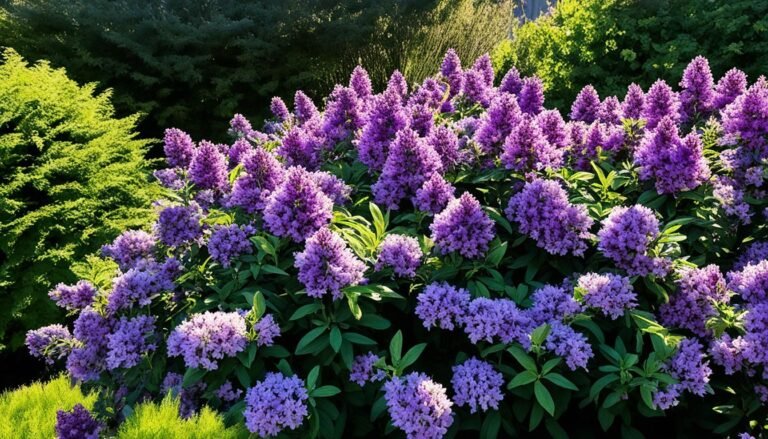When I first started gardening, I was drawn to the vibrant colors and unique blooms of flowering shrubs. One particular combination that caught my eye was purple and white flowers. There was something about the contrast of these colors that added a touch of elegance and sophistication to any garden. I knew I had to incorporate these beautiful shrubs into my own landscape.
As I delved into the world of purple and white flowering shrubs, I discovered a wide array of options to choose from. Each shrub had its own unique characteristics and benefits, making the decision even more exciting. From low-maintenance options to those that attract butterflies and bees, there was something to suit every gardener’s preference.
I couldn’t help but imagine how stunning my garden would look with pops of purple and white throughout. The vibrant hues would create a visual feast for the eyes and provide a focal point in my landscape. I could picture myself relaxing in the garden, surrounded by the calming beauty of these blooming shrubs.
So, I set out on a journey to explore the world of purple and white flowering shrubs. I learned about different types of salvias with their exquisite purple blooms, the delightful purple catmint loved by bees and butterflies, and the climbing morning glory with its trumpet-shaped flowers.
I also discovered wild violets, which not only added beauty to my garden but also provided excellent ground cover. Teasels, with their spiky leaves and attractive purple flower heads, brought a unique visual appeal to my landscape. And let’s not forget the beloved lavender with its calming scent, or the ornamental alliums with their round purple blooms.
Butterfly bushes and clematis were also favorites of mine, attracting vibrant colors and vertical interest to my garden.
Key Takeaways:
- Purple and white flowering shrubs add vibrant contrast and beauty to any garden.
- There are various types of shrubs with purple and white flowers to suit different preferences and garden styles.
- From salvias to catmint, morning glory to lavender, there is a wide range of options to choose from.
- Consider the growing zone, sunlight requirements, and maintenance preferences when selecting the perfect shrub.
- Enjoy the visual appeal, calming scents, and the buzzing of bees and fluttering of butterflies in your garden.
Types of Purple Salvias
Salvia is a popular genus of shrubs that includes many varieties with purple flowers. Purple salvias are a stunning addition to any garden, with their vibrant blooms and attractive foliage. These shrubs not only add a burst of color to your landscape, but they also attract pollinators like butterflies and bees.
One notable variety of purple salvia is Salvia pachyphylla, which features beautiful lavender-purple flowers. This shrub is highly prized for its exceptional heat and drought resistance, making it a low-maintenance choice for gardeners.
Another popular type is the Blue salvia, known for its deep purple flowers. This variety is particularly prized for its hardiness and ability to tolerate dry conditions, making it suitable for various climates and garden styles.
One more fascinating type of purple salvia is the Clary sage, which displays purple, pink, or white bracts that add an enchanting touch to the garden. This variety is beloved for its unique flower structure and eye-catching color combinations.
Summary
Purple salvias offer a wide range of choices for garden enthusiasts looking to incorporate these beautiful flowering shrubs into their landscapes. From Salvia pachyphylla and the Blue salvia to the captivating Clary sage, there are numerous purple salvia varieties available to add elegance and charm to your garden.
| Variety | Features |
|---|---|
| Salvia pachyphylla | Heat and drought resistance |
| Blue salvia | Hardiness and drought tolerance |
| Clary sage | Purple, pink, or white bracts |
Beautiful Purple Catmint
When it comes to adding a touch of purple to your garden, Catmint is an excellent choice. This shrub produces beautiful purple flowers that are not only visually stunning but also attract bees and butterflies. Catmint, scientifically known as Nepeta, is a bushy perennial that thrives in full sun and well-drained soil.
One popular variety of Catmint is Nepeta cataria, which can grow up to 24 inches tall and features vibrant purple flowers. This flowering shrub adds a pop of color to any garden and creates a mesmerizing visual display. Additionally, Catmint is known for its aromatic foliage, adding a delightful fragrance to your outdoor space.
If you love herbal teas, you’ll be delighted to know that Catmint is often used in tea blends. Its leaves can be dried and steeped to create a soothing and flavorful tea. Not only will you enjoy the beauty of Catmint in your garden, but you can also reap the aromatic and herbal benefits.

Benefits of Catmint:
- Produces beautiful purple flowers that add vibrant color to your garden.
- Attracts bees and butterflies, promoting pollination and biodiversity.
- Thrives in full sun and well-drained soil, making it easy to grow.
- Creates a stunning visual display with its bushy and tall growth habit.
- Known for its aromatic foliage, adding a pleasant fragrance to your garden.
Whether you’re a seasoned gardener or a beginner, Catmint is a fantastic choice for adding purple blooms to your landscape. Its beauty, fragrance, and ability to attract pollinators make it a versatile and captivating shrub.
Gorgeous Morning Glory
Morning glory is a climbing plant that features trumpet-shaped flowers in shades of purple, blue, pink, and white. It blooms in the morning and is a favorite among butterflies and hummingbirds. Grandpa Ott’s Morning Glory is a popular variety with intense royal-purple flowers and a reddish star-shaped throat. Another variety is the common Morning Glory, which has deep purple flowers with white throats.
| Variety | Flower Color | Throat Color |
|---|---|---|
| Grandpa Ott’s Morning Glory | Purple | Reddish |
| Common Morning Glory | Deep Purple | White |
Morning glory adds a touch of whimsy and charm to gardens with its vibrant blooms. Its climbing nature makes it perfect for trellises or fences, where it can create a stunning display of cascading flowers. The dual colored flowers of morning glory, including purple and white, add visual interest and create a beautiful contrast in any landscape. Whether you choose the bold hues of Grandpa Ott’s Morning Glory or the classic charm of the common Morning Glory, these shrubs are sure to make a statement in your garden.
Wild Violets for Ground Cover
When it comes to adding a touch of classic purple beauty to your garden, you can’t go wrong with wild violets. These lovely flowers are a perfect choice for temperate forests and shady areas in your landscape. Not only do they enhance the natural beauty of your outdoor space, but they also provide excellent ground cover and accentuate trees.
Wild violets are well-known for their low-maintenance nature, making them a hassle-free addition to your garden. They are tolerant of drought conditions and can re-seed themselves, creating a sustainable and thriving ground cover. With their resilience and ability to spread, wild violets will effortlessly fill in empty spaces and bring life to shaded areas.
Varied Shades of Purple
The striking beauty of wild violets lies in their various shades of purple. From rich, deep purples to soft, lavender hues, these flowers come in an array of stunning colors. This diversity allows you to create a visually captivating landscape by incorporating different shades of wild violets throughout your garden.
If you’re looking to highlight specific areas or create an eye-catching contrast, you can pair wild violets with other flowering plants. Their purple blossoms beautifully complement white flowers, creating a charming and harmonious color combination in your garden.
Benefits of Wild Violets
Aside from their aesthetic appeal, wild violets offer several practical benefits for your garden. Here are some key advantages:
- Increase biodiversity: Wild violets attract bees and other beneficial pollinators, promoting biodiversity in your garden.
- Prevent soil erosion: As a ground cover, wild violets help prevent soil erosion by stabilizing the soil and reducing water runoff.
- Suppress weed growth: With their dense foliage, wild violets restrict the growth of weeds, keeping your garden clean and tidy.
- Provide natural habitat: These flowers create an inviting habitat for small mammals and insects, supporting a thriving ecosystem in your garden.

Wild Violets Table
| Common Name | Scientific Name | Blooming Season | Height |
|---|---|---|---|
| Pansy Violet | Viola tricolor | Spring to summer | 4-6 inches |
| Common Blue Violet | Viola sororia | Spring | 3-8 inches |
| Sweet Violet | Viola odorata | Spring | 6-8 inches |
“Wild violets are nature’s gift, versatile and resilient. Their beautiful purple flowers and lush foliage make them a delightful addition to any garden.” – Me
Teasels for Visual Appeal
Teasels are wildflowers that have spiky leaves and attractive purple flower heads. They are often considered weeds, but they can make great garden plants that attract beneficial insects and birds. Dipascus fullonum is a European native with spiked purplish flower heads that provide food for pollinators. This shrub is an ideal addition to wildlife gardens.
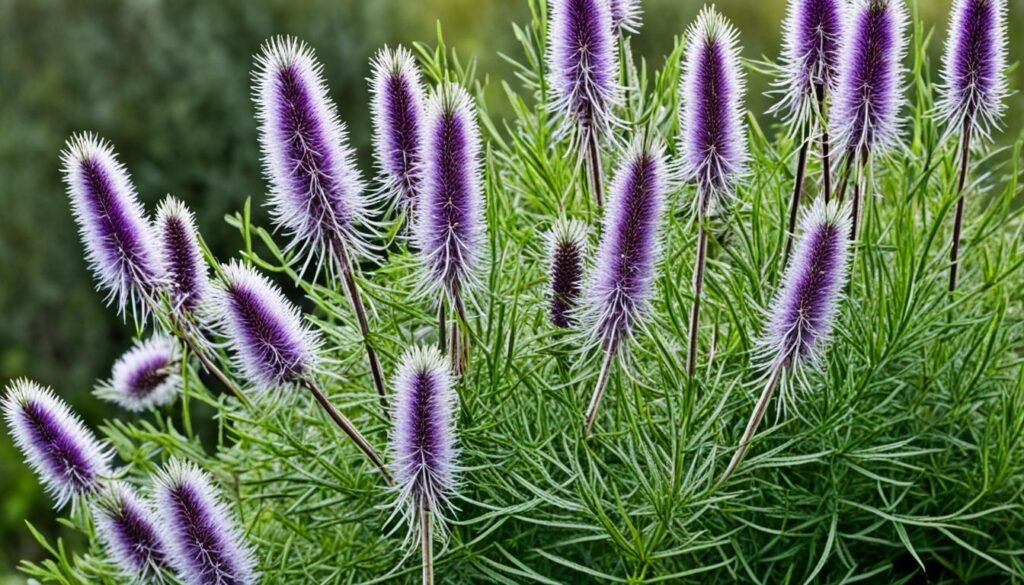
| Teasels | Benefits |
|---|---|
| Attractive purple flower heads | Add visual appeal to the garden |
| Spiky leaves | Create texture and interest in the landscape |
| Attract beneficial insects and birds | Support pollinators and enrich biodiversity |
| Provide food for pollinators | Ensure a sustainable ecosystem |
Lovely Lavender Shrubs
Lavender is a highly aromatic perennial plant with purple flowers. It is known for its calming scent and is often used in aromatherapy. There are many varieties of lavender to choose from, with some having purple flowers. English lavender and Lavandin are two popular species that produce purple blooms. Lavenders are great for cottage and Mediterranean-style gardens, as well as wildlife gardens.
| Variety | Description |
|---|---|
| English lavender | A traditional lavender variety with fragrant purple flowers. It grows in compact mounds and is ideal for borders or containers. |
| Lavandin | A hybrid lavender species that has longer stems and larger flower spikes. It is often grown for commercial use in the production of essential oils. |
| <insert lavender variety> | <description of the lavender variety> |
Benefits of Growing Lavender Shrubs
- Lavender attracts pollinators such as bees and butterflies, making it beneficial for your garden’s ecosystem.
- The calming fragrance of lavender can help promote relaxation and reduce stress.
- Lavender is a low-maintenance plant that requires minimal watering once established.
- It adds a pop of color to your garden with its vibrant purple flowers.
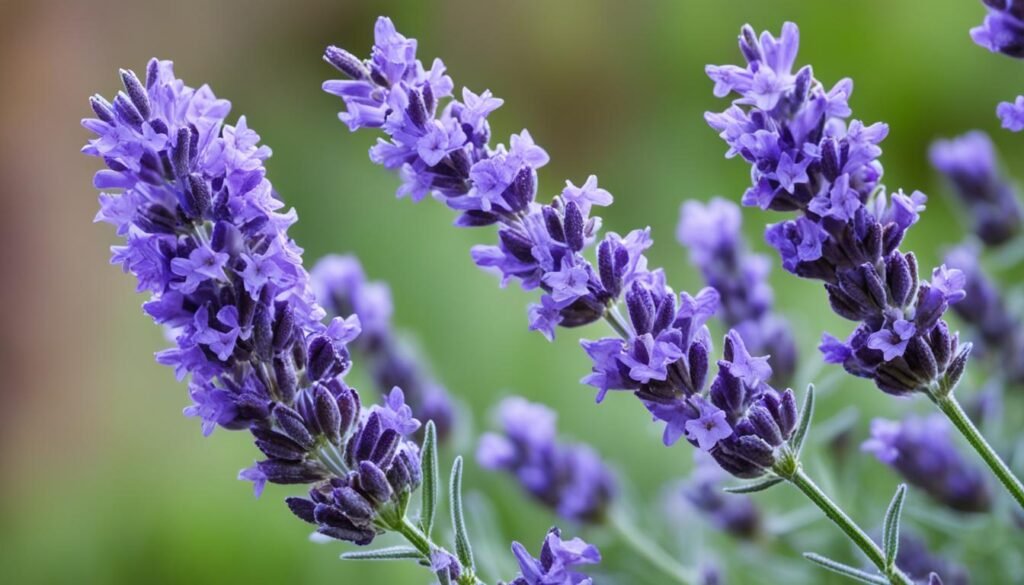
“Lavender is not only visually pleasing but also has numerous therapeutic qualities that make it a valuable addition to any garden.” – Gardening Expert
Alliums for Unique Blooms
Allium is a genus that includes onion and garlic, as well as ornamental varieties with beautiful round blooms. These stunning flowers come in various shades, including purple, making them a unique and eye-catching choice for your garden. Alliums are not only visually appealing, but they also attract pollinators, adding life and movement to your outdoor space.
There are several popular varieties of purple alliums, each with its own distinct characteristics. Here are three noteworthy options:
- Purple Sensation: This variety features dark-reddish-purple flower heads that add a touch of drama and elegance to your garden. Its tall stems make it perfect for border plantings or as a centerpiece in flower beds.
- Purple Rain: With blooms that resemble delicate umbrellas, Purple Rain adds a whimsical and romantic element to any landscape. Its lilac-purple flowers create a soft and enchanting ambiance, especially when planted in clusters.
- Mars: Mars alliums boast vibrant and eye-catching deep purple flower heads. Their compact size makes them ideal for containers, borders, or rock gardens, adding bursts of color and texture to your outdoor space.
To showcase the unique beauty of alliums, consider planting them in sunny spots where they can receive ample sunlight. This will help the flowers thrive and display their vibrant hues to the fullest extent. Alliums are relatively low-maintenance plants, making them an excellent choice for both beginner and experienced gardeners.
| Allium Variety | Flower Color | Height | Best Uses |
|---|---|---|---|
| Purple Sensation | Dark-reddish-purple | Tall | Border plantings, centerpiece |
| Purple Rain | Lilac-purple | Medium | Clusters, romantic gardens |
| Mars | Deep purple | Compact | Containers, rock gardens |
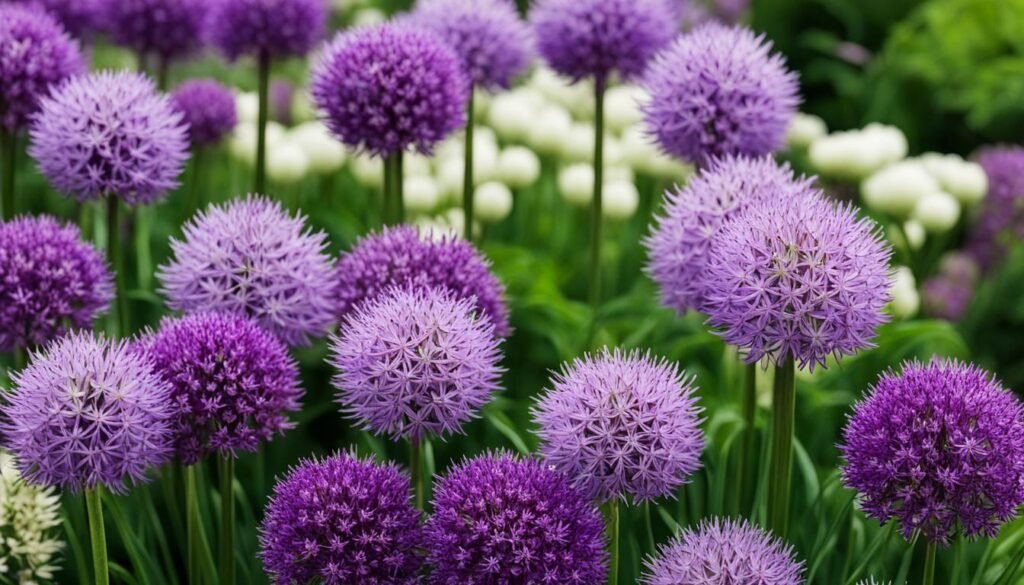
By incorporating alliums into your garden, you can create a unique and visually striking display. These exquisite flowers with their shades of purple will undoubtedly be a talking point and a standout feature in any landscape. Whether planted as border plants, in clusters, or in containers, alliums are sure to impress with their distinctive blooms and ability to attract pollinators.
Butterfly Bushes for Vibrant Color
When it comes to attracting butterflies to your garden, butterfly bushes are the perfect choice. These beautiful shrubs are known for their ability to attract these delicate creatures with their vibrant purple and white flowers. The butterfly bush (scientifically known as Buddleia davidii) is one of the most common varieties and is beloved by both gardeners and butterflies alike.
The tall and elegant butterfly bush features clusters of purple flowers that create a stunning display of color in any garden. These blooming clusters not only add vibrancy but also provide a nectar-rich food source for butterflies. You can expect a constant flurry of butterfly activity as they flutter from flower to flower, sipping on the sweet nectar.
To ensure the success of your butterfly bushes, it’s important to plant them in an area that receives full sun. These shrubs thrive in bright, direct sunlight, which helps promote healthy growth and abundant flowering. Additionally, butterfly bushes prefer lime-rich soil, so be sure to amend the soil if necessary to create the optimal growing conditions.
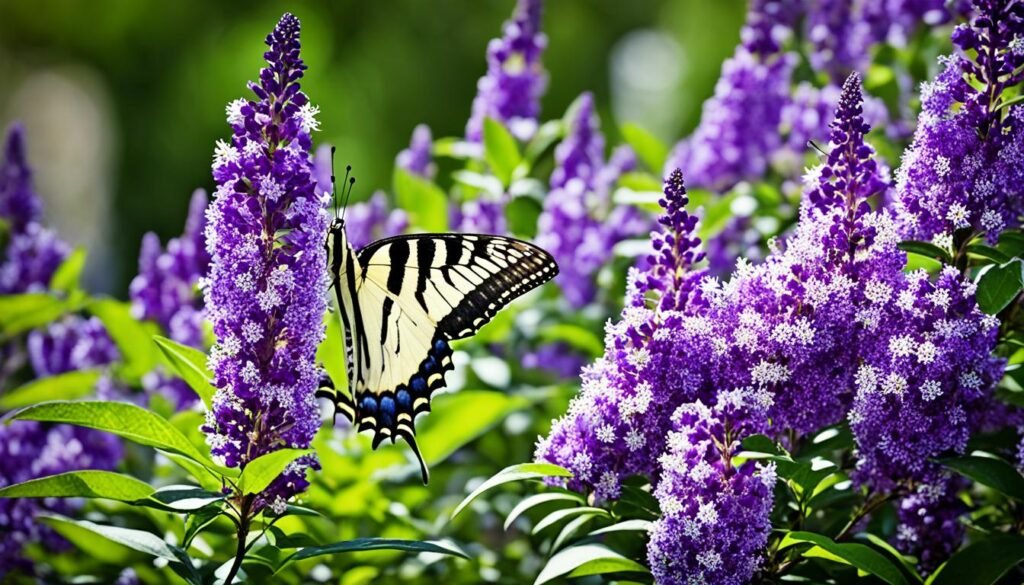
When it comes to maintenance, butterfly bushes are relatively low-maintenance. They require regular watering, especially during dry spells, but be cautious not to overwater as they prefer well-drained soil. Pruning is another important aspect of caring for butterfly bushes. Pruning helps maintain a compact and tidy shape while also encouraging more vigorous growth and abundant flowering.
If you’re looking to add vibrant color and attract butterflies to your garden, consider planting butterfly bushes. Their stunning purple and white flowers will not only bring joy to your outdoor space but also provide a haven for these beautiful creatures. Sit back, relax, and enjoy the enchanting sight of butterflies floating among the blooms of your butterfly bushes.
Clematis for Vertical Interest
If you’re looking to add vertical interest to your garden, clematis is a stunning vine that is sure to impress. With its beautiful purple flowers, clematis adds a touch of elegance and color to any outdoor space. From light violet to deep royal purple, there are numerous varieties of clematis to choose from, each with its own unique beauty.
Clematis is a versatile plant that can be trained to grow on trellises, arbors, or fences, creating a vertical display of vibrant blooms. Whether you want to cover a bare wall or add some height to your garden, clematis is the perfect choice.
“Clematis is like a painter’s brush, adding strokes of purple to the canvas of your garden.”
If you’re not sure which purple clematis variety to choose, here are a few popular options:
- Kingfisher: This variety of clematis features large, velvety purple flowers that bloom in abundance.
- Picardy: With its deep violet flowers and contrasting yellow anthers, Picardy is a striking addition to any garden.
- Etoile Violette: Known for its abundant blooms and rich purple color, Etoile Violette is a favorite among gardeners.
- Night Veil: This clematis variety boasts dark, almost black flowers with a velvety texture, adding a touch of drama to your garden.
- Warszawska Nike: With its large, star-shaped flowers and deep purple color, Warszawska Nike is a showstopper.
When planting clematis, it’s important to provide proper support and care. These vines generally prefer full sun to partial shade and well-drained soil. Regular pruning is also necessary to promote healthy growth and abundant flowering.
Did you know?
Clematis is a member of the buttercup family and is native to many parts of the world, including North America, Europe, and Asia.
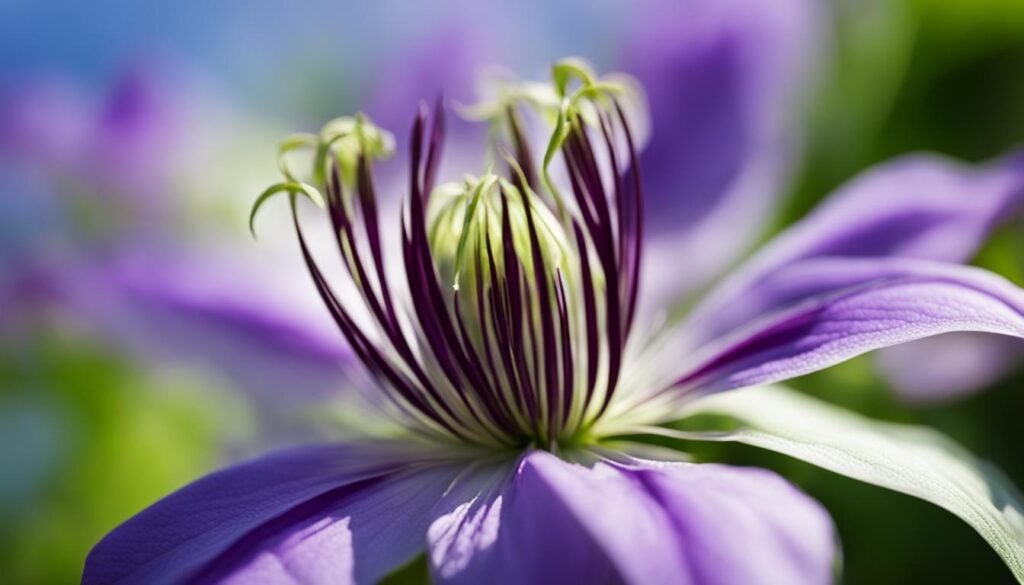
Conclusion
Purple and white flowering shrubs are a stunning addition to any garden, bringing vibrancy and beauty to your outdoor space. Whether you prefer the charming purple salvias, the captivating purple catmint, or the gorgeous morning glory, there are numerous options to choose from. These shrubs not only provide visual interest but also attract butterflies and bees, adding a touch of wildlife to your garden.
When selecting the perfect shrub for your garden, consider factors such as your growing zone, sunlight requirements, and maintenance preferences. Some shrubs, like wild violets and catmint, are known for their low-maintenance nature, while others may require more care and attention. By understanding the specific needs of each shrub, you can create a thriving and beautiful landscape.
With their stunning colors and unique blooms, purple and white flowering shrubs are sure to make a statement in your garden. Create eye-catching displays by combining different shrub varieties or use them as focal points to enhance vertical spaces. No matter how you choose to incorporate these shrubs into your landscape, they will undoubtedly bring joy and visual interest to your outdoor space.
